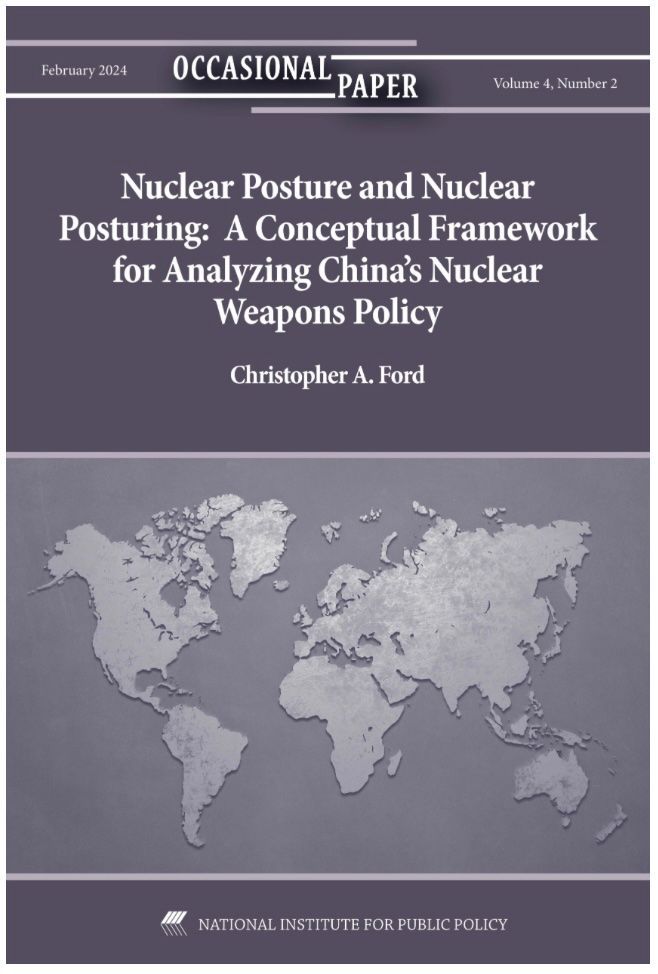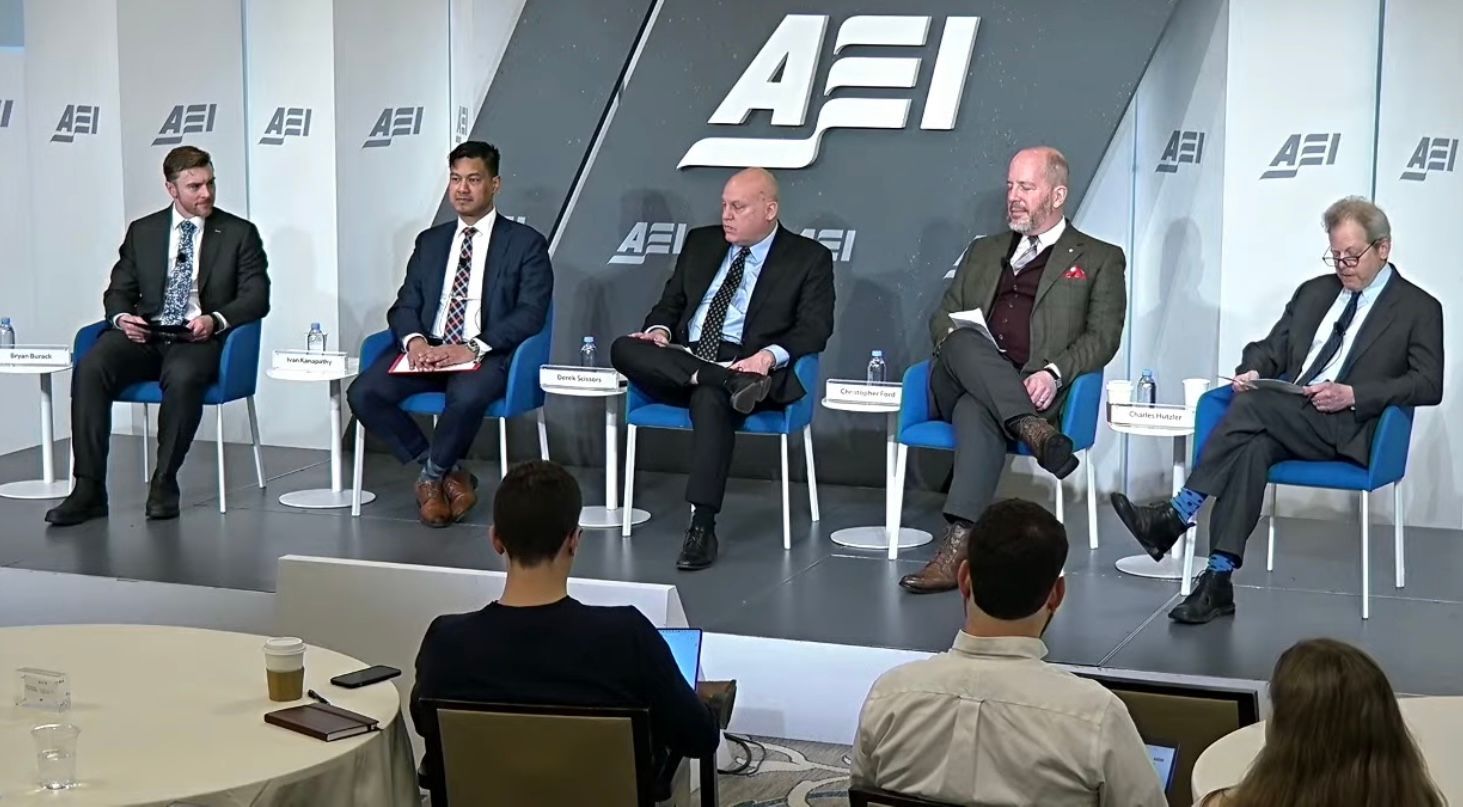The Hon. Christopher A. Ford
New Paradigms Forum -- International Security Policy Since 2009
Post-START Numbers and Nuclear Modernization
Do you remember what Defense Secretary Robert Gates said – way back in December 2008, when he worked for President George W. Bush – about the strategic arms negotiations the Bush Administration had begun with Russia to replace the Strategic Arms Reduction Treaty (START) of 1991? Gates declared that “there is a real possibility of going down below the 1,700 to 2,200 deployed warheads” range set by the 2002 Moscow Treaty. He warned, however, that there were limits on how far the United States could probably go: “ I’d begin to get pretty nervous if we begin to talk about below 1,500 [warheads] just in view of the array of countries developing these systems and modernization programs in both Russia and China.” By a remarkable coincidence, as the Obama Administration puts the finishing touches on its new post-START strategic arms deal with Russia, we are told that the limit on deployed warheads set by the new agreement will be – wait for it – 1,550. What a coincidence!
Thoughtful coverage of this new post-START limit of 1,550 has deservingly revolved around how modest a reduction it is, since this figure is a mere 150 weapons below the bottom of the 1,700-2,200 range band that President Bush agreed with Russia eight long years ago. Few people, if anyone, seem to think that this reduction is an intrinsically bad idea, however, and Gates’ comment highlights the degree to which these talks, which were begun by the Bush Administration in September 2006, have been concluded on essentially Bush Administration terms – at least with respect to the raw numbers. (Let’s leave verification and missile defense for another day, once it has become clear what this new agreement will actually say in these important regards.) The text of the treaty that will be signed in April hasn’t been released yet, but it seems that delivery systems are to be reduced more than warheads, with the total permissible number of missiles and bombers coming down to 800 from the 1,600 permitted by START.
[ Note: The original posting of this essay replicated a mistake in the New York Times’ reporting of the post-START deal , which declared incorrectly that “The number of nuclear-armed missiles and heavy bombers would be capped at 700 each.” In fact, according to the White House’s own fact sheet on the new treaty, the agreement features separate limits on total versus deployed delivery systems as follows: “ [a] combined limit of 800 deployed and non-deployed ICBM launchers, SLBM launchers, and heavy bombers equipped for nuclear armaments” and “[a] separate limit of 700 deployed ICBMs, deployed SLBMs, and deployed heavy bombers equipped for nuclear armaments .” NPF readers should take note that the limit on bombers, alone, is emphatically not to be 700! (That would, it has been pointed out to me, be an awful lot of bombers ....) Thanks to an attentive reader for drawing my attention to the error.]
To be sure, it is a bit discomfiting to have such reductions agreed before the Obama Administration has gotten around to identifying and articulating a U.S. nuclear weapons policy in the first place. The new administration’s Nuclear Posture Review (NPR) is greatly delayed, and while no one doubts that it will end up saying things consistent with the now-agreed post-START framework – the White House, of course, would not permit its NPR to say otherwise – there is a whiff here of the political and arms-negotiating cart leading the strategic policy horse. Nevertheless, the numbers aren’t shocking, and probably bode well for the new treaty’s eventual Senate ratification.
In effect, President Obama has added modest reductions of hundreds of warheads and delivery systems to President Bush’s remarkable reduction of thousands , and few commentators are likely to complain too much – even if Obama’s more starry-eyed political allies may now be squirming at how little was actually done in this agreement, and his arms control advisors fretting about how long and difficult a negotiating process this turned out to be. (There now turns out to be nothing particularly “reset” about the U.S.-Russian strategic arms relationship, except in uncomfortable ways. If anything, the parties have “reset” their negotiating dynamics – which is to say, regressed – to an adversarial mid-1980s milieu. The congenially codified reciprocated unilateralism of President Bush’s Moscow Treaty now seems a thing of the distant past.)
To my eye, however, the most interesting thing about the new deployed strategic warhead limit of 1,550 weapons is in the degree to which it so closely follows the cautionary note offered by Secretary Gates during the Bush Administration. (In fact, the agreed number exceeds by 50 weapons the level below which Gates said he would become “nervous.”) The Obama Administration’s post-START agreement, therefore, would seem to be an all but explicit acknowledgment that ongoing Russian and Chinese modernization of their nuclear forces is becoming a brake upon U.S. nuclear disarmament. This needs to be much better understood in the disarmament community than it appears to be today.
Russia and China are both today working to replace or augment ageing silo-based missile systems with advanced mobile missiles; both Russia and China are building new classes of ballistic missile submarine with new missiles; and both have reportedly – Russia “apparently” and China “possibly” – been working on new warhead designs in part through the use of secret low-level nuclear explosive testing in violation of their no-testing promises. China is the only NPT nuclear weapons state to be increasing the size of its nuclear arsenal , while Russia retains thousands of so-called “tactical” nuclear weapons and has refused fully to implement the pledges it made in the 1990s regarding reductions in such devices. Moscow has also adopted an increasingly nuclear-weapons-friendly strategic doctrine, and hasn’t been shy about conducting exercises in which it practices using such weapons on Eastern European countries that are now U.S. allies.
If the missions of U.S. nuclear forces include the classic deterrence role of holding at risk the forces of a potential adversary, the shift to more survivable mobile missiles creates new challenges for targeteers, even as potential adversaries’ ongoing modernization work on delivery systems and warhead designs increases the dangers of U.S. technological surprise. This creates pressures to retain larger numbers of warheads and delivery systems than would otherwise be the case, and incentives to resume or continue advanced research and development that might otherwise be felt less necessary. As Gates’ remarks indicates, nuclear weapons proliferation also threatens to increase the problem, by adding yet more potential targets that planners may feel they have to be able to hold at risk in order to provide deterrence. Hence the Secretary’s comment about becoming “nervous” below 1,500 deployed warheads – which should really have surprised no one, and which seems to reflect an underlying reality of strategic policy that transcends U.S. presidential administrations.
One doesn’t hear the disarmament community talking about the braking effect of foreign modernization and nuclear weapons proliferation upon U.S. disarmament, of course, for many of its leading lights still seem to remain ideologically intoxicated by the perverse notion that the United States is the root of all evil in the arms control world. (Russia and China are afterthoughts, when considered at all. These powers will, it is patronizingly and implausibly assumed, follow obligingly when we “lead by example.”) It’s quite clear, however, that U.S. strategists have noticed the challenge. If there is to be any meaningful hope of deep U.S.-Russian arms reductions after this post-START deal – rather than merely another round of showy but smallish cuts designed to permit the Obama Administration to insist that its repeated promises of “further steps” toward disarmament weren’t just opportunistic politically-correct puffery – some answer will have to be found to handling this tension.
One answer to the problem of this braking effect might be somehow to constrain Russian and Chinese nuclear work. To describe Moscow and Beijing as being utterly uninterested in such constraints, however, would be dramatically to understate the problem, and the odds of real progress in this regard seem very low. (Verification of modernization restrictions would also be quite an interesting challenge.)
An alternative approach is to take affirmative U.S. steps to more obviously level the potential future playing field by moving America back into the modernization business, as a means to safeguard against technological surprise and to permit reductions to continue. President Obama pledged in his famous April 2009 speech in Prague that “ [a]s long as these weapons exist, the United States will maintain a safe, secure and effective arsenal to deter any adversary, and guarantee that defense to our allies.” His Under Secretary of State for Arms Control and International Security, Ellen Tauscher, has declared that “ [a]s long as we see the rise of nuclear weapons in other countries, we will maintain a deterrence [sic] that is second to none.” At what point might the conceded need to maintain such nuclear deterrence – especially with ever-smaller numbers of systems and warheads pursuant to the Obama’s disarmament agenda – require the United States stop being the only weapons possessor on the planet not to be modernizing its forces?
Let’s stop and take stock for a moment, for some readers have challenged me on the claim that the U.S. is alone in not modernizing. As noted, Russia and China are modernizing on multiple axes. France has a brand new class of ballistic missile submarine, the fourth of which has just entered service, and is currently testing a new missile for it. The British decided in December 2006 to begin building a new ballistic missile submarine themselves. India and Pakistan are both thought to be modernizing their delivery systems as rapidly as they can, in addition to building new weapons – and in India’s case this work includes building a ballistic missile submarine, which was launched last year and is said to be undergoing sea trials. Even Israel, a country long presumed by most observers to possess nuclear weapons but which has famously refused either to confirm or to deny this status, is rumored to be developing an improved capability to launch nuclear-armed cruises missiles from its own submarines. North Korea, of course, just conducted its second nuclear test last year , and is working on ever more advanced ballistic missiles in defiance of U.N. Security Council missile testing prohibitions.
As for the United States, however, we’ve scrapped thousands of warheads and delivery systems under START and the Moscow Treaty, and made more cuts such as with the Bush Administration’s decision in 2007 to retire our stock of advanced air-launched cruise missiles and to increase the rate of U.S. nuclear warhead dismantlement. The United States is building no new ballistic missiles and no new submarines, and while there apparently now do exist plans for some kind of “next generation” bomber, no decision seems to have been made on whether it will actually be “dual-role” ( i.e. , nuclear capable) at all. Under President Bush, there were efforts to look into the possibility of two “new” nuclear weapons designs – an earth-penetrator weapon and a design with improved safety and security features and intended to obviate any future need to resume nuclear testing. (Technically speaking, these were less “new” weapons than modifications of older designs, but this subtlety escaped most critics.) This work, however, involved no more than design and feasibility studies, and both programs were in any event scrapped amidst a firestorm of criticism. Washington has been for some time, therefore, indeed the sole nuclear “player” actually to be both reducing our forces and refusing to modernize them.
The coincidence between Secretary Gates’ comments about Russian and Chinese modernization and the limit on the number of deployed warheads that will appear in the post-START agreement, however, suggests that this U.S. status may not too long be sustainable. It is perhaps for this reason that the Obama Administration’s latest budget request includes money to study the possibility of a new air-launched cruise missile , to study the potential design of a follow-on ballistic missile submarine to replace today’s aging Ohio class boats , a “ life-extension program” for the B-61 nuclear bomb that could involve the incorporation of some new features in order to permit this old weapon to remain reliable, and studies to determine the future status of the next-generation bomber.
As yet, these budget requests have not been funded, and to study the possibility of something is of course not the same thing as actually deciding to procure it. But the Obama Administration clearly is laying the groundwork for a U.S. return to the modernization business. There are also rumors of anxious efforts within the Administration to figure out how much can be added to a nuclear weapon design without having to call it a “new” device: there is clearly interest in squeezing as much as they can get away with, politically speaking, under the rubric of “life extension” modifications. Perhaps tellingly, Under Secretary Tauscher said last month merely that the U.S. will acquire “no new nuclear weapons capabilities.” This isn’t necessarily the same thing as acquiring no new weapons , and in fact sounds much like Bush Administration policy statements about how the “reliable replacement warhead” would “have the same military capabilities as the warhead it replaces.”
If Obama does follow the lead of all the other nuclear weapons possessors and return America to an agenda of at least limited nuclear force modernization, this step should not necessarily be regarded as a victory for the hawks or a defeat for the doves. A solid case can be made – and the Administration has already begun to make it – that ensuring the reliability and future viability of U.S. warheads and delivery systems is an essential prerequisite to any serious disarmament agenda. Obama seems to remain committed to disarmament, but he has stated quite plainly that we should not hold our breath for abolition. “ This goal,” our young president declared in Prague, “will not be reached quickly – perhaps not in my lifetime.” On the long road to this destination, he expects an ever-smaller U.S. arsenal to remain adequate to handling whatever nuclear missions are felt to remain.
Even within the ambit of Obama’s disarmament vision, therefore, if a stable and reliable “zero” proves unfeasible before U.S. forces encounter block-obsolescence problems with existing delivery systems or unforeseen technical glitches with our Cold War-era warhead designs – and here one should remember that our current cruise missile is expected to reach the end of its service life by 2030 , and the Ohio class submarines perhaps ten years later , both dates within Barack Obama’s likely lifetime – we’ll need something new to bridge the gap. Since such steps unfortunately require painfully long lead times, it stands to reason that both hawks and sensible doves should be willing to embrace some nuclear force modernization: the former will presumably feel such moves to be better than the current status quo ( i.e. , no modernization at all), while the latter should recognize that deep U.S. reductions depend upon maintaining a credible arsenal as numbers shrink.
Such a shift in posture would not be easy for the Obama Administration to sell to its political supporters on the left, at home and abroad, but it may prove necessary all the same – both for the preservation of U.S. national security interests and for the political and substantive survival of the president’s disarmament policy as a viable and intellectually credible agenda.
-- Christopher Ford



Copyright Dr. Christopher Ford All Rights Reserved






